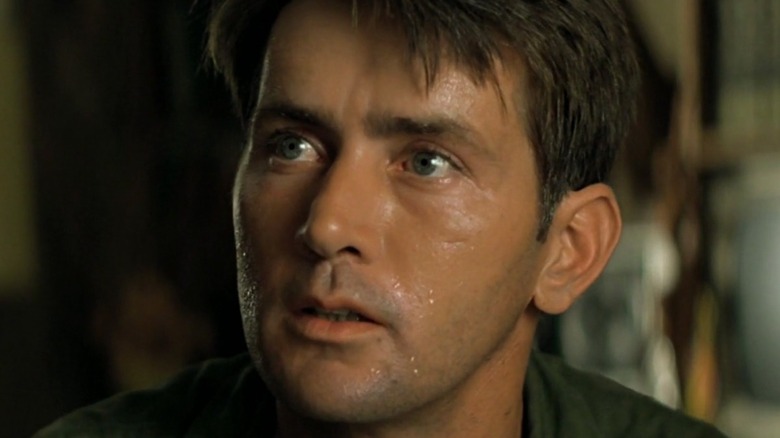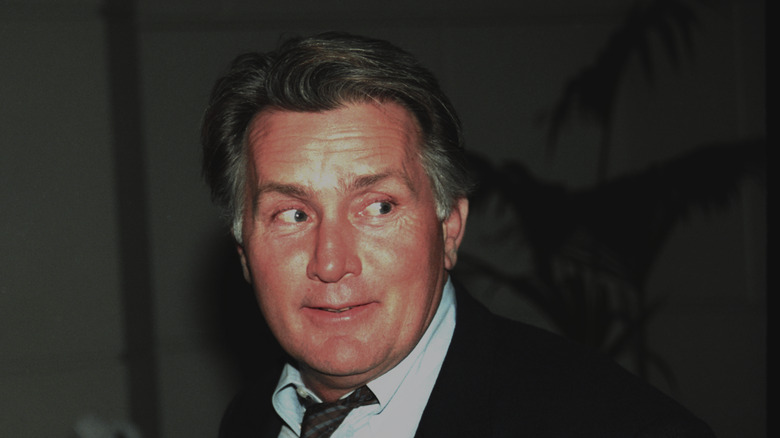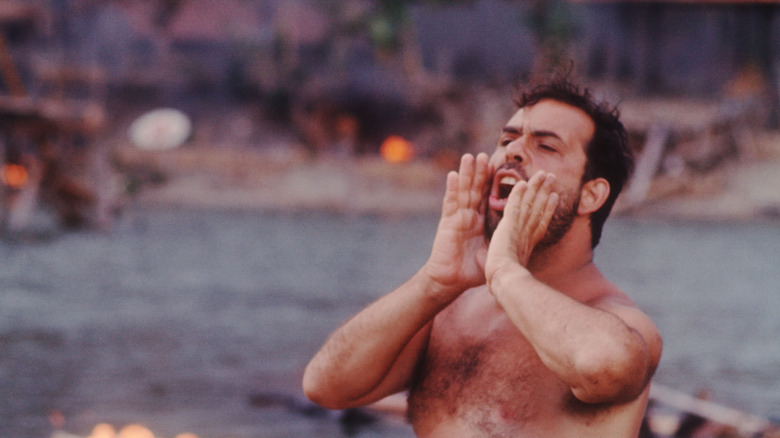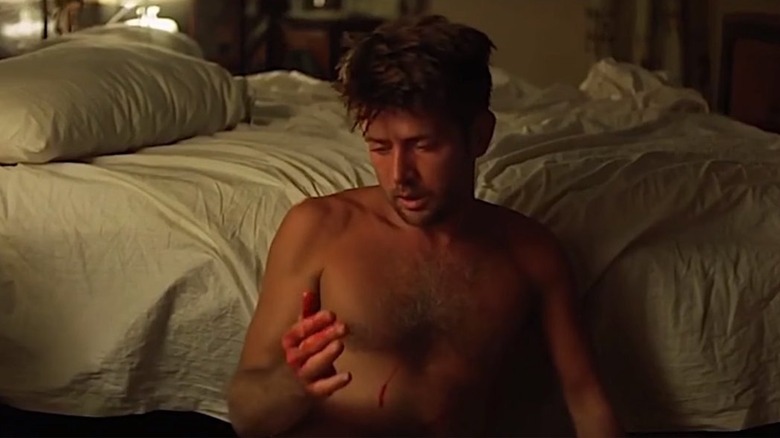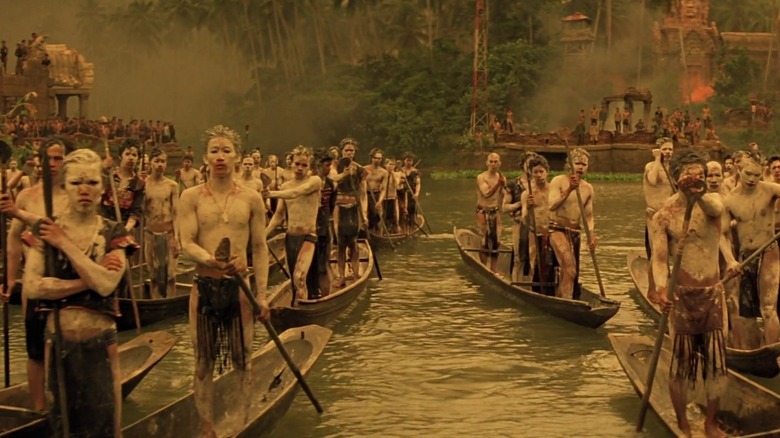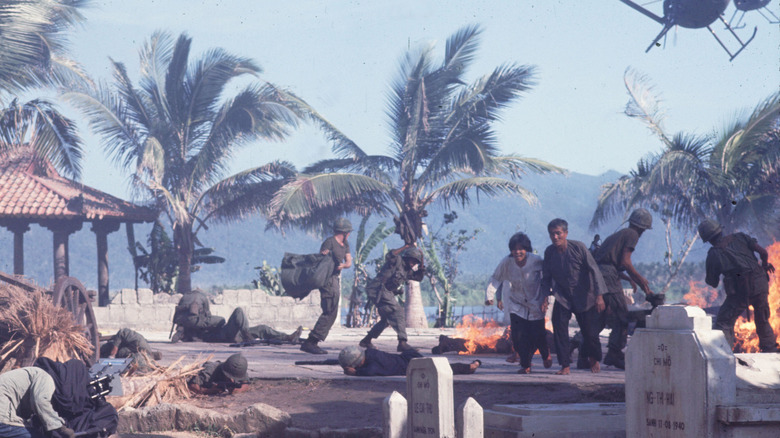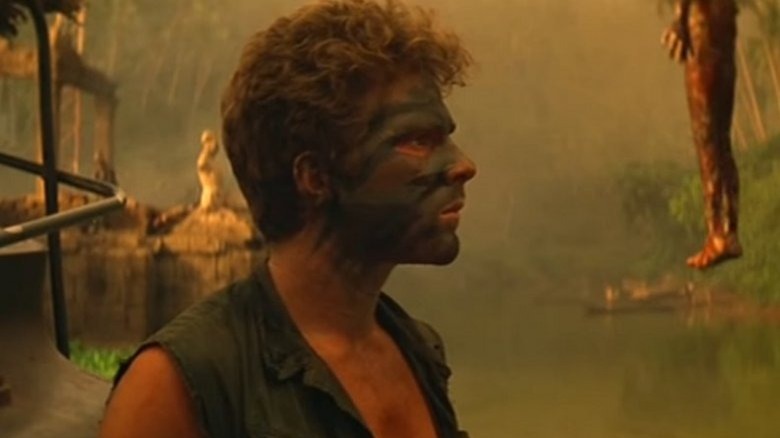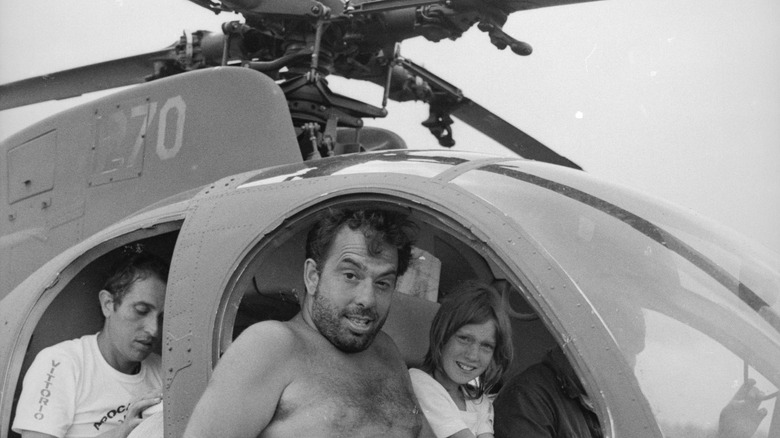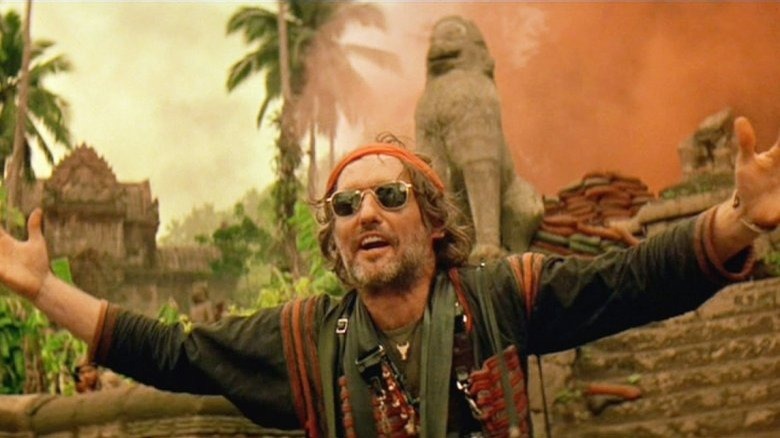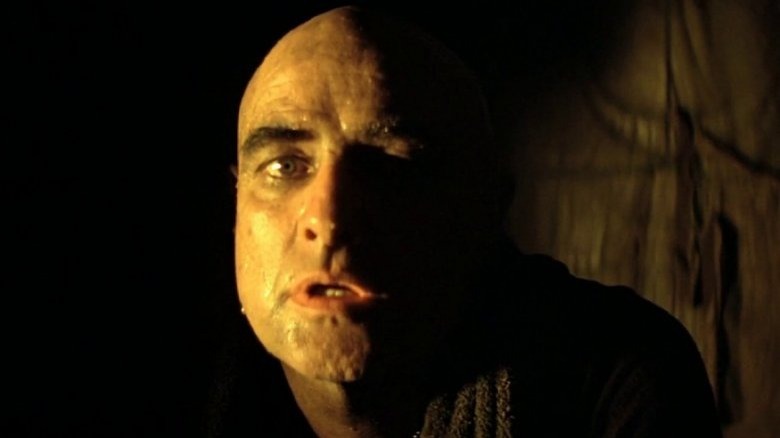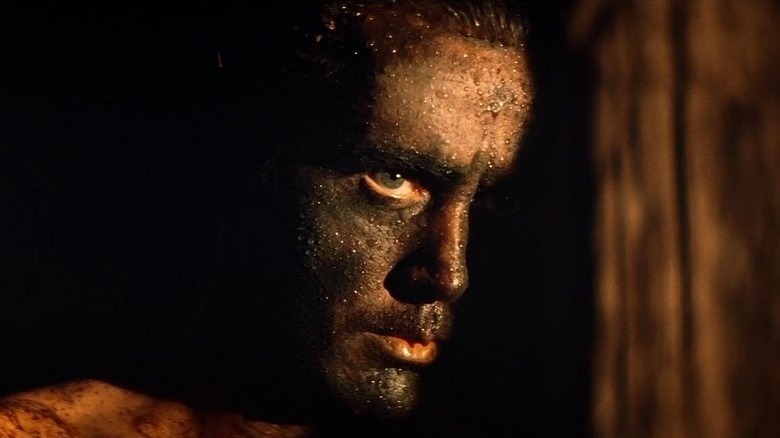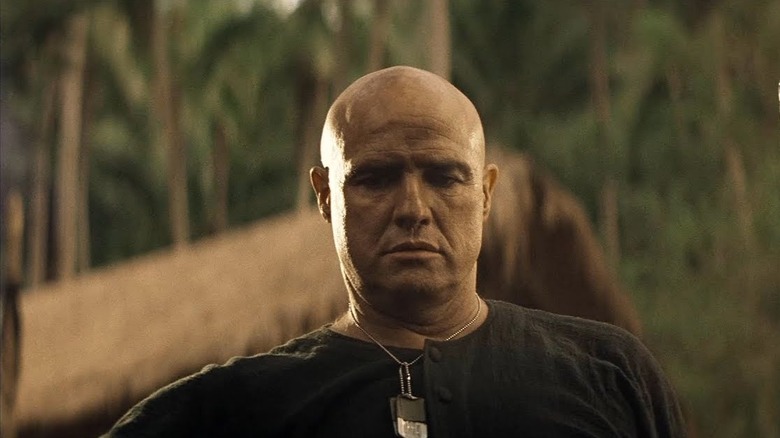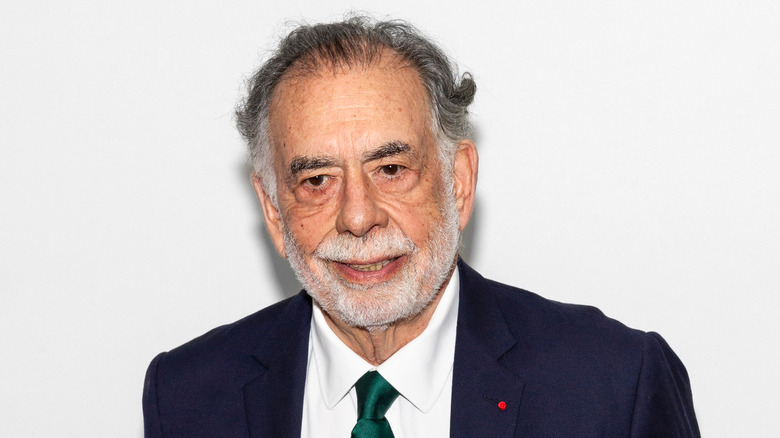Bizarre Things That Happened On The Apocalypse Now Set
If you've heard any stories about Francis Ford Coppola's 1979 film "Apocalypse Now," you're probably aware that the brutal film came about on an equally tumultuous set. While initially planned to be shot over14 weeks, it would become an astounding 238-day shoot, most of which was filmed in the jungle of the Philippines. Even before the film began shooting, there were problems. "Apocalypse Now" was originally going to be directed by George Lucas, but by the time production began he was busy working on "Star Wars."
The cast of the film changed early on as well. Harvey Keitel was originally cast as the lead, but Coppola decided he wasn't right for the part and he was let go only two weeks into the shoot. Keitel was replaced with Martin Sheen, who would go on to give a career-defining performance –- at an immense cost. While the budget was originally set at $12 million, it would go on to cost over $30 million to produce and was still never truly finished, at least in Coppola's eyes. In 2001, Coppola released "Apocalypse Now Redux," in which he added an extra 49 minutes that was originally cut from the 147-minute theatrical release. In 2019, he remixed yet another version of the film, entitled "Apocalypse Now Final Cut," which he says is the final final version of the film.
You may think all of this drama is enough to sink your teeth into, but that's not even the half of it. The truth of the movie is far stranger than fiction. Gird your loins and read on to discover the bizarre things that happened on the set of "Apocalypse Now."
Martin Sheen had a heart attack on set
Everyone involved in the production of "Apocalypse Now" maintains that it was an exceedingly difficult shoot, but it seems no one had a harder time than the film's star, Martin Sheen. Sheen was already beginning to fall apart shortly after filming started, in large part due to the pressure Coppola was putting on him. As one crew member told Rolling Stone, Coppola "did a dangerous and terrible thing. He assumed the role of a psychiatrist and did a kind of brainwashing on a man who was much too sensitive. He put Martin in a place and didn't bring him back."
When Sheen went home to Malibu after the shoot was shut down due to weather, he was hesitant to return to set. He argued with Coppola and demanded more money. "Never got it, the bastard," Sheen said. "Francis and I battled over that and had a very heavy falling-out. We reconciled and I went back."
Sheen's hesitance to come back to set was well-founded, it seems. After returning to the Philippines, Sheen had a heart attack that nearly took his life. Luckily, he was able to walk out into the street and was picked up by a passing bus and eventually taken to a doctor. Sheen was convinced he was going to die and even had a priest read him his last rights. According to Sheen, he also had a nervous breakdown during that period, and his hair and beard turned grey at the age of 37.
Coppola had his own health issues
Martin Sheen wasn't the only one to experience physical and emotional ailments while filming "Apocalypse Now." Following Martin Sheen's heart attack, Coppola had his own nervous breakdown and suffered an epileptic seizure, as remembered by The Guardian. The film quickly went over budget, and Coppola spent several million dollars of his own money financing the project. The shoot became so taxing that Coppola reportedly declared his intention to commit suicide on three different occasions, according to The Independent.
Despite all of these setbacks, Coppola remained committed to completing the film, no matter what. Coppola was so dedicated to the project that the Los Angeles Times reported that he told his bosses at the studio, "Even if he dies, he's not dead until I say so," referring to Sheen's health problems. Despite all of the problems on set, Sheen remained grateful -– albeit belatedly –- for Coppola's tenacity. "He just would not be denied, and he accepted challenges at a personal level. He never waned — never! We almost hoped he'd throw in the towel, for our sakes. But he wouldn't. He would adjust," Sheen told The Guardian in 2001.
If you or anyone you know is having suicidal thoughts, please call the National Suicide Prevention Lifeline at 1-800-273-TALK (8255).
That was Martin Sheen's real blood when he punched the mirror
The opening scene of "Apocalypse Now" is an impactful sequence, and the story behind the scene is even more shocking. The film starts with Sheen's Willard in a hotel room in Saigon, naked and drunk, as he waits for information about his next mission. He jumps around the room practicing karate and then suddenly stops in front of the mirror to take in his reflection. Angry with what he sees, he rams his fist into the mirror, cutting his hand and spreading blood all over his face and body.
As it turns out, the scene wasn't movie magic at all. As a crew member recounted to Rolling Stone, Coppola "kept Martin drunk for two days before that scene, kept him locked up," and would tell him "terrible things" that devastated Sheen. When they shot the actual scene, Sheen was actually drunk, and he really did punch the mirror and start bleeding everywhere. According to Coppola's wife, Eleanor, Coppola resisted the impulse to yell cut and instead kept filming. After the scene ended, Sheen was severely drunk and wouldn't stop singing Christian hymns, even as he was bleeding through his bandages. It took Coppola, Eleanor, and a nurse two hours to get him into a car and back to the hotel.
That was a real water buffalo being killed
Sheen's bloodied hand wasn't the only scene where extreme realism was the name of the game. All of "Apocalypse Now" was filmed on location in the Philippines, which means the cast and crew often interacted with locals as a part of their shoot. The production team made a deal with the local tribe to film on their land, and part of this deal stipulated that they be given livestock, such as chickens and pigs, to use for ritual slaughter. Two water buffaloes were also a part of the deal. "That was a big part of their compensation," Coppola said during a Q&A for "Apocalypse Now Final Cut," per USA Today.
One day his wife, Eleanor, who is a documentary filmmaker, witnessed the sacrifice of the first water buffalo. Coppola decided to film the sacrifice of the second water buffalo, something that would not have been allowed had the film been made in the United States due to laws about animal cruelty on set. Though it wasn't technically illegal, Coppola and the crew did get some flack for the scene, with the American Humane Association labeling the film "unacceptable" after its release.
Coppola has since defended including the scene in the movie, noting that "I did not direct it or anything, that was the way they do it." He also declined to keep another water buffalo in waiting in case the first take didn't work out, maintaining that "I'm not going to kill an animal for a movie."
A typhoon caused a huge delay in production
Though many of the issues on the set of "Apocalypse Now" had to do with the turbulence of human behavior, one of the most significant problems the production faced was all natural. Two months after the start of filming, the Philippines was hit by Typhoon Olga. As shown in "Hearts of Darkness," the documentary Eleanor Coppola co-directed about the production, most of the sets were destroyed, and production had to be shut down for three months. Some members of the crew were stranded in their hotel rooms for some time, and many houses were demolished. Not only did this put the production way behind schedule, but it caused major budget issues as well.
When production finally resumed, there were even more problems. Following the unscheduled hiatus, Variety reports that "The U.S. military refused to cooperate, and there were claims that the governments of Australia and Philippines were pressured to deny production assistance to the film, which was considered to be taking a negative look at America's role in Vietnam." To make matters even more complicated, Rolling Stone remembers that Sheen refused to come back to the Philippines unless he received a significant raise. While Coppola denied his request, Sheen eventually came back of his own accord.
They almost used real dead bodies in one scene
We've already established that "Apocalypse Now" contains real blood and animal sacrifice, but it almost contained something even more disturbing. According to The Independent, one morning during shooting, Sheen's wife, Janet, took the film's co-producer, Gray Frederickson, to the temple set where they were shooting that day. The location was a mess, as it was covered in garbage and smelled awful. Janet demanded that the set be cleaned up, arguing that it was a health hazard. Frederickson took her complaint seriously and went to see the production designer, Dean Tavoularis. When Frederickson discussed the issue, Tavoularis was nonplussed and claimed the atmosphere was intentional. Nearby, a prop guy joked, "Wait till he hears about the dead bodies."
Frederickson was understandably shocked by the comment and demanded to know more. He was then taken to the prop store –- which happened to be right behind the tent where everyone ate dinner -– and shown a row of dead bodies laid on the ground. Frederickson was livid but was told they would look great strung up on trees during the shoot. Apparently, the prop team got the cadavers from someone who procured bodies for medical students but was actually a grave robber.
Shortly after Frederickson discovered the room full of bodies on set, the police showed up and took everyone's passports, leading to some tense moments as they tried to figure out where the bodies had come from. However, the truth eventually came out when the police caught the grave robber and got rid of the cadavers, while the film crew used extras strung up in trees instead.
The helicopters in the film were rented from the Philippine government
Helicopters are a hugely iconic part of "Apocalypse Now," and the story behind them is just as strange as you might expect. Since the United States military refused to be involved in the film's production, Coppola reached out to the Philippine government for assistance. He was able to get a meeting with Philippine President Ferdinand Marcos, and he convinced Marcos to lend him helicopter gunships for the duration of the shoot.
This was all well and good, but the problem was the helicopters were frequently flown off to fight rebel armies in the real-life war happening in the Philippines. According to a retrospective featured on Cinephilia & Beyond, this also meant that the helicopters had to be repeatedly re-painted in American military colors every time the helicopters were recalled. Coppola once said he thought some of the pilots were high on heroin when they flew off into battle.
It took three weeks to film the Air Cavalry attack in the film, and it was a pretty hazardous situation. There was no supervisor in the air, making it difficult to get the helicopters all in one shot. Cinematographer Vittorio Storaro kept asking the pilots to get closer to one another, even though a crash would have been disastrous. The explosion scenes were done with actual napalm, and, according to cast and crew, the heat could be felt from half a mile away. Luckily, all of this danger led to some pretty incredible sequences, namely the opening shot of helicopters flying across the scene in front of the fiery jungle –- something Coppola created from previously discarded footage.
The production supplied Dennis Hopper with drugs
It's no surprise that drugs and alcohol were prevalent on the set of "Apocalypse Now," as the conditions the cast and crew were working in were pretty harrowing. While Martin Sheen had his own troubling relationship with alcohol during the production, Dennis Hopper became dependent on drugs to get through a day of shooting. Like many members of the cast and crew, Hopper struggled a lot during production. As told to The Independent by George Hickenlooper, co-director of the "Apocalypse Now" documentary "Hearts of Darkness," Hopper had a conversation with Coppola about what exactly he required to continue on.
Coppola asked Hopper what he could provide to help him play the role, and Hopper responded, "about an ounce of cocaine." From this point on, Hopper was being given drugs by the production crew so that he could play the role of an unhinged photojournalist.
According to co-producer Gary Frederickson, "That's the way he was, on and off camera. But he was fun and everybody loved him. There wasn't an edge to his craziness at all." But while Frederickson didn't have a problem with Hopper's methods, some of the crew found him a bit more difficult to handle. "Dennis was known at that time for never taking a shower," said production assistant Doug Claybourne. "You didn't want to stand too close to him."
If you or anyone you know is struggling with addiction issues, help is available. Visit the Substance Abuse and Mental Health Services Administration website or contact SAMHSA's National Helpline at 1-800-662-HELP (4357).
Marlon Brando and Dennis Hopper hated each other on set
Considering Dennis Hopper's on-set antics, it should be no surprise that the ever-serious Marlon Brando didn't get along very well with his co-star. According to Hopper, he only agreed to do "Apocalypse Now" on the condition that he would be in a scene with Brando. The Hollywood Reporter recalls that the reality of the situation was much less hopeful.
Brando initially arrived on the set weeks after he had been scheduled to start, which meant the entire crew had been waiting for him. Hopper had already been there for over a month, training in the jungle with his team. The conflict between the two men began at dinner one night. During his preparation for the film, Hopper had been given a "little red book" used by the Green Berets. Unbeknownst to Hopper, Coppola had been harassing Brando for not having read the book "Heart of Darkness," on which the film was based.
During a cast dinner, Hopper tells Brando, "I bet you haven't read the book," referring to the one he was given by production. Brando thought he meant "Heart of Darkness" and angrily stormed away. After this, Hopper made it his mission to irritate Brando and hurled insults at him whenever he could. Following the incident, Brando declared that he would consent to be in the film but would never be on set with Hopper. As such, their scenes together were filmed on different nights.
Someone on the construction crew died during filming
It's been well established that "Apocalypse Now" was a dangerous, oftentimes volatile set. The helicopters flying overhead, real-life napalm explosions, and the unpredictable nature of the jungle all made for some pretty difficult filming conditions. Speaking at a Q&A for "Apocalypse Now Final Cut," Coppola emphasized just how dangerous it really was. "We were up in the air when flares were hitting us," he said. "One of the things I'm so proud of is we did not lose one person."
Realizing his mistake, Coppola quickly walked back his statement. "One person was lost on a construction crew ... which is one too many. But it was extraordinary that we did all that we did with all this flying around and the explosions." According to a biography of Marlon Brando, a Filipino worker was struck and killed by a log while a set was under construction. While many of the bizarre events that happened on the film set seem pretty horrific, this one is undoubtedly the most tragic.
Marlon Brando shaved his head without telling anyone
Much has been said about Marlon Brando's presence on the set of "Apocalypse Now." He apparently showed up weighing a lot more than Coppola expected, and, as the story goes, he was completely unprepared for the shoot and hadn't read the source material. Brando also demanded a salary of $1 million per week for three weeks of work, something he claimed years later he never received, according to The Independent.
Despite claims that he was unprepared for the shoot, Brando had ideas on how to come into his own as Colonel Kurtz. After being on set for several days, Brando came to set with a whole new look -– a shaved head. Luckily, it ended up working out for the character. "I can't believe my eyes," Coppola recalled. "His whole head is shaved ... and that meant to me, that's Kurtz!"
Contrary to the story that is often told, Professor Susan L. Mizruchi argues on Huff Post that Brando had a lot to do with shaping the film, and his decision to shave his head was in line with how Colonel Kurtz was described. According to Mizruchi, he had read the source novel "Heart of Darkness" (several editions of the book were found in his library), and letters between Brando and Coppola seem to reveal that the director relied a lot on Brando's vision of the film during production. Whatever the truth of the story may be, it's clear that Brando's presence on set was hugely impactful either way.
Coppola insisted on having special food flown in
"Apocalypse Now" is one of the most famous examples of a film going way over budget, but looking at Coppola's indulgences while in the Philippines, you wouldn't know it. While the film crew was traveling to Manila so they could shower, Coppola was combating his bouts of depression and binge drinking with extravagant culinary purchases, according to The Guardian. Despite budget issues, Coppola demanded that his pasta be flown in from Italy. Then, on his 37th birthday, he had an entire plane filled with hot dogs flown in from San Francisco.
Coppola continued his indulgent, self-immolating streak, later hiding inside a luxury resort that happened to be located inside an active volcano. With the world falling apart around him (literally), Coppola staunchly refused to face the music, hiding from the pressures of Hollywood and the politics back home -– a little bit like Colonel Kurtz, actually. As his wife Eleanor recalls in her documentary about the making of the film, Coppola once took a break from a particularly harrowing day of production -– typhoons, helicopters being recalled, and the like –- to stop and make a delicious meal. "Francis has decided to make pasta, and he's turned on 'La Boheme' full volume."
Ever the food lover, Coppola now owns a restaurant in San Francisco and has been a winemaker for decades.
